Menu
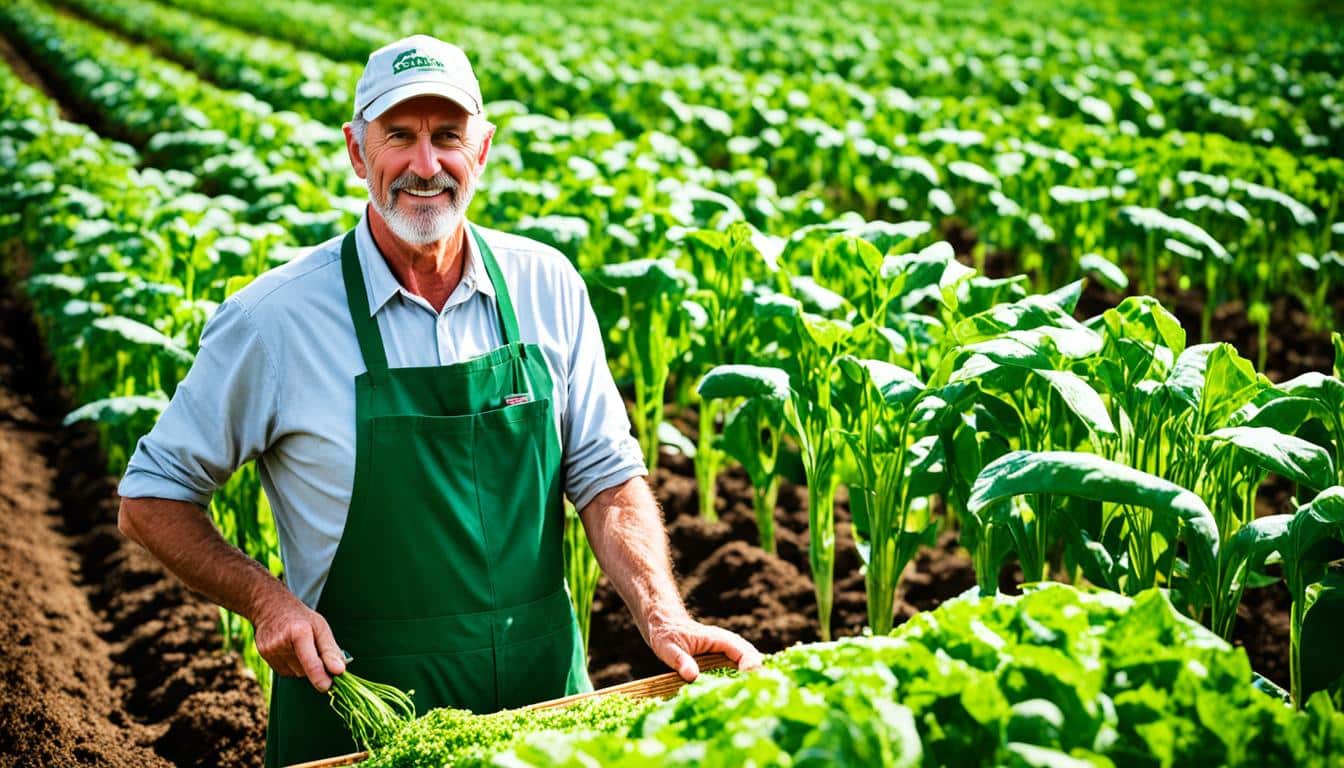
Did you know agriculture uses only 3 percent of the 440 million tons of plastic made each year? Yet, it uses a huge 14 million tons of plastic! 80 percent of this plastic goes into growing crops and raising animals. This much plastic in farming is bad for the environment.
Plastic films, like black mulch and greenhouse covers, make up more than 8 million tons of global plastic use each year. These help grow more food and use less water but also harm the soil. Using plastic on just one acre of land makes over 120 pounds of waste. This is a big problem for our planet.
It’s clear we need to find better, more earth-friendly ways to farm. Using plastic for farming might make things easier, but it’s not good for the planet. Moving to materials that break down naturally and not using dangerous plastic chemicals is a big step forward. This change fits with what the United Nations wants on plastic use.
Farming must be sustainable, meaning it should not hurt the earth. This change needs better checks, new ideas, teaching, and ways to make it good for business.
Plastics in farming have become very common. They are used in many ways that make farming easier. But, using so much plastic is harming our planet.
This is a big deal because farming causes a lot of bad stuff for our world. It creates a lot of greenhouse gases and uses a lot of energy. It also uses a ton of our land and water. Plus, it’s one of the main reasons we cut down so many trees. All these things together are damaging our planet.
Over the last 70 years, farmers have started using more and more plastic. Each year, they use about 12.5 million tons of it. Half of this plastic is just for plastic mulch films. These films are used a lot more in Europe and Asia than in North and South America.
Using plastic films can be good. They help save water and cut down on pesticides and fertilisers. This is better for the environment. But, we’re worried if this is a good long-term plan. We need to find ways to farm that are both good for the earth and keep farms productive.
In Japan, they’ve been using special plastic-coated fertilisers since the late 1970s. This has helped make farming more efficient. But, every year, agriculture uses 14 million tons of plastic. Most of this plastic is for growing crops and raising animals. This is a problem we need to solve.
Farmers around the world use a lot of plastic films. Every year, they use more than 8 million tons. This is as much as it would take to cover the whole of Idaho. But, using all this plastic also creates a lot of rubbish. For every acre farmed this way, there’s over 120 pounds of waste. This is wasteful, even if it does help grow more food.
The worry is that there will be a lot more plastic waste in the future. By 2060, there could be three times more plastic waste. This is bad news, as most plastic waste comes from new plastic, not recycled ones. Making plastic and getting rid of it creates a lot of pollution. It’s something we must find a better way to deal with. The solution is to farm in a way that doesn’t harm the earth.
The UN tells us that using plastic in farming needs to be more careful. Some places found that using plastic in the soil is bad for the crops. They’re looking for better ways to farm that don’t use so much plastic. In the US, those growing food organically are asked to use mulches that are not harmful. Making laws to reduce single-use plastic at the same time can help a lot.
Plastic use in farming is very wide-ranging. Its effects are found in everything we do on the farm. But, we’re beginning to see that using so much plastic can hurt the soil. This can affect the plants we grow and the animals that depend on them. Farming used to be less wasteful, but now, because of the plastic, we create a lot of rubbish. It’s time to find better ways to farm.
Plastic in the soil is a big worry everywhere. Tiny bits of plastic come from many different things, like containers and plastic mulch. These small bits can hurt the soil and its life. It’s not good for the plants and animals. We need to be more careful with how we use and get rid of plastic.
Plastics are heavily used in farming, leading to environmental problems. This includes soil contamination and the spread of microplastics. Each year, agriculture uses a huge 12.5 million tons of plastics. This causes soil and biodiversity issues.
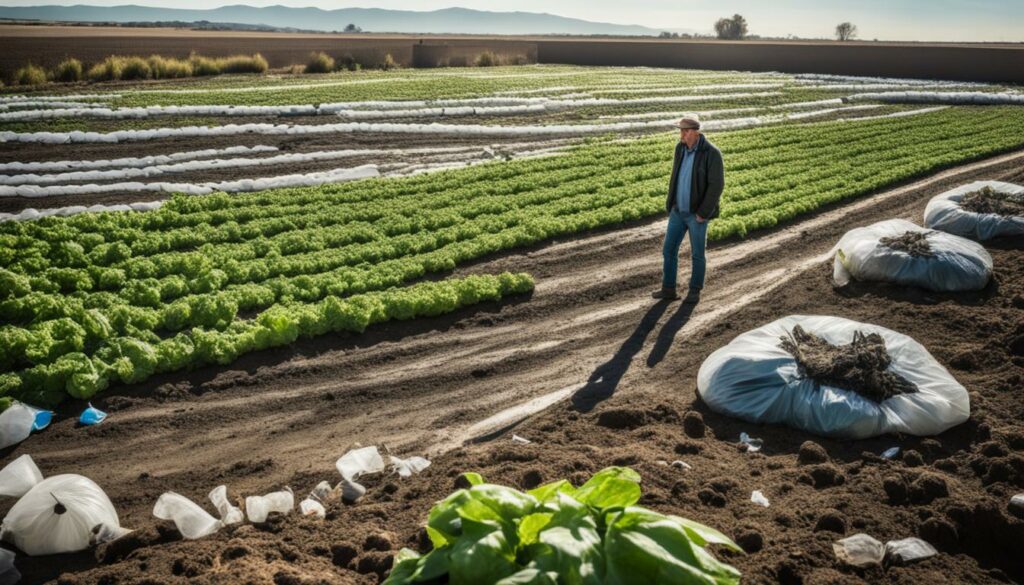
Plastics, like mulch films, affect soil greatly. In China, enough plastic film is used yearly to cover Idaho. This practice harms soil and lowers crop yield. Plastics break down into microplastics, damaging soil health.
Plastics damage soil and threaten biodiversity. They release harmful chemicals into the soil. This hurts crop growth and human health. Plastic use in Japan from 1976 to 2018 led to soil degradation. This affects root growth and plant health, harming ecosystems.
Dealing with plastic waste in farming is key. Though only a small part of global plastic production, farming plastics are problematic. These plastics pollute natural spaces and are set to increase by 2060. In March 2022, 175 countries made a crucial pact to fight plastic pollution. The goal is to introduce compostable films and eco-friendly farming to reduce plastic’s harm.
Plastics in farming have grown a lot in the last 70 years, now amounting to 12.5 million tonnes each year. Things like plastic mulch films, greenhouse covers, tunnels, seed trays, and irrigation tubes play a big role. They have changed the way we farm.
Plastic mulch films are critical for today’s farming, making up half of all agricultural plastic. They help with weed and pest control, keep soil moisture in, improve taking up nutrients, and boost crop yields. If not for these films, China alone would need nearly 4 million more hectares to grow enough food. Use of these films, from 10-20 kg/ha in the Americas to 40-50 kg/ha in Europe and Asia, varies worldwide.
Plastic covers and tunnels also play a big part in farming, especially for creating ideal growth conditions for crops. The FAO says over 8 million tonnes of plastics are used globally in this way every year. This shows the need for farming practices that are both productive and good for the planet.
Seed trays and irrigation tubes help farm nurseries and manage water well. They’re key for growing seeds and distributing water effectively in big farms. But, they can also create a lot of plastic waste, about 120 pounds every acre. This means we need to find better ways to deal with this waste and develop new solutions.
Plastics have changed modern farming by helping crops grow better and handling nutrients well. For the last 70 years, plastic mulch films and other tools have improved farming productivity. They’ve made a big difference in the way we farm today.
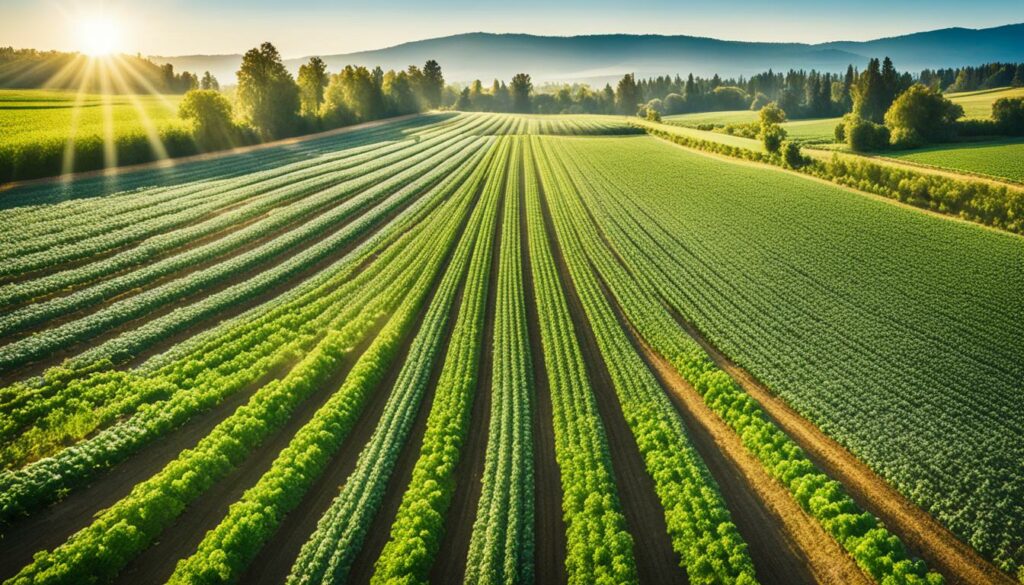
Plastic mulch films boost how much we can grow. They fight off weeds and pests, keep the soil moist, control temperatures, and help plants use more nutrients. In Europe and Asia, farmers use about 40-50 kg of plastics per hectare. In North and South America, it’s about 10-20 kg per hectare. This means we need less pesticide and our crops are better.
Plastics help us use water better in farming. Hoop houses keep plants warm, making the growing season longer. They also protect crops from bad weather. Special plastics on fertilisers control when nutrients are released. This matches when plants need them, saves water, and reduces pollution.
Plastics are great for keeping pests and weeds away. Strong plastic netting protects crops from birds and pests. It keeps our crops safe and helps them grow better. This netting also cuts the wind by 85% and light by 25%. It’s a key shield against the effects of climate change.
Because we need more food from our farms, plastics are really helpful. They make better use of resources and help us grow more. Plastics are key in many aspects of farming today. They help with high yields, using water wisely, and promoting sustainable agriculture.
| Region | Plastic Mulch Film Usage (kg/ha) |
|---|---|
| Europe | 40-50 |
| Asia | 40-50 |
| North America | 10-20 |
| South America | 10-20 |
The use of plastics in farming has helped a lot. But, getting farms to use less plastic is tough. This is because there isn’t enough money to try new things and not many good options. The problem is big, and it’s one of the hardest things about farming sustainably today.
Plastics are popular in farming because they’re cheap, easy to use, and do many jobs. Plastic mulch films, for example, are used a lot. They help control weeds and pests, keep the soil moist, and help plants get more nutrients. In Europe and Asia, these films cover lots of land, showing how important they are.
But, not using plastics would mean big changes and a lot more land would be needed in some places. Farmers worry that if they stop using plastic, they might not grow as much food. So, the farming industry isn’t quick to try new, less plastic ways.
One big issue is that we don’t have great options to use instead of plastic. The choices available now don’t last as long or work as well as plastic does. There are rules, like the USDA saying use plastics made from plants, but it’s hard to make these the norm.
We really need to find and use new materials and ways of doing things. For example, in Japan, farmers used special fertilisers that help save nitrogen and cut down on pollution. This shows how new materials can make a real difference.
| Region | Plastic Mulch Film Usage (kg/ha) | Alternative Challenges |
|---|---|---|
| Europe and Asia | 40-50 | High dependency, economic constraints |
| North and South America | 10-20 | Operational transition issues |
We need to work on different things at the same time to solve the plastic problem in farming. By using materials that can be used again and again, making new things with better ideas, and using things differently, we can cut down on the need for plastic in farming. We must do this without reducing how much food we grow.
Agricultural plastic use has surged to about 12.5 million tons yearly. This growth highlights the need for better recycling methods. Using high-efficiency techniques and more eco-friendly materials helps reduce environmental harm.
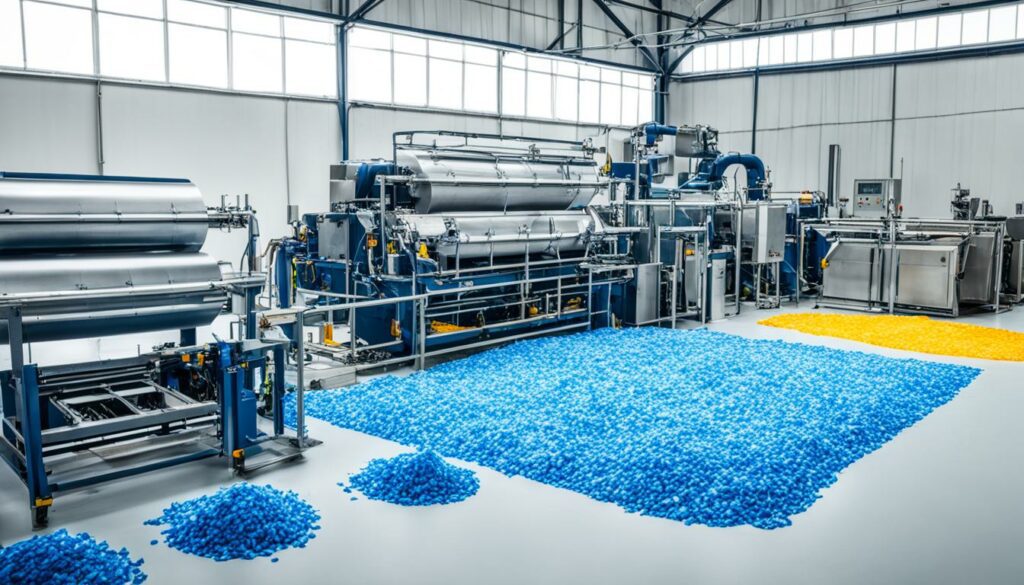
Mechanical recycling is crucial in addressing plastic waste in farming. It involves reclaiming plastic through mechanical means. This cuts down on pollution. The process includes collecting, sorting, cleaning, and reshaping plastics. It’s a cost-effective and environmentally friendly way to give used plastic a new life.
Chemical recycling is a step up from mechanical processes. It breaks plastics into their base components using chemicals. This method is great for contaminated or mixed plastic waste. It prevents landfill waste and creates materials for new products. Investing in chemical recycling helps with agricultural plastic waste and cuts down on environmental dangers.
Turning to biodegradable plastics is a great step to lower pollution in farming. These plastics are made from plants or natural sources. They decompose quickly, reducing soil and water pollution. Using these, along with strict quality standards, keeps farming productive without harming the environment.
| Region | Plastic Mulch Film Usage (kg/ha) |
|---|---|
| Europe and Asia | 40-50 |
| North and South America | 10-20 |
To lower the high costs on our planet, modern farming should go green. This means using methods that care for nature while making the farm’s money last. Eco-friendly farming isn’t just good for the earth, it helps farmers’ wallets in the long run.
Choosing biodegradable mulch films is a big step in the green direction. These films break down in the soil, not sticking around to harm the environment. Since farming is big on releasing greenhouse gases and using a lot of plastic, a green change is necessary.
Currently, about half of farming’s plastic use comes from mulch films. This hurts our land and soils. But, by using biodegradable ones, the farming world could skip out on over 12.5 million tons of plastic every year. That’s a huge win for the planet.
Moving towards organic farming is key. It means less fake stuff and more working with nature. But, making sure eco-friendly stuff really works can be tough. The aim is to find ways that help the earth and are still really effective.
In places like China, using less plastic could save a lot of land for farming. Without plastic mulch films, nearly 4 million hectares more land might be needed to grow food. Organic farming cuts back on the massive energy and land use of agriculture worldwide. It’s a vital step for the future of our food and the planet.
The world’s farmers use a lot of plastic. This huge amount causes big problems for our planet. Because of this, leaders around the world are creating strong rules to cut down on how much plastic farmers can use.

Countries all across the globe are joining forces. They want to make strict rules to tackle the plastic problem. For example, the Paris Climate Agreement sets important goals. Something like this, but just for plastic, is the United Nations Plastics Treaty. This treaty is a big step towards stopping the pollution that comes from using too many pesticides and plastic in farming. Many countries are working together to solve this issue. They have started a $379 million plan. Through this plan, they aim to stop more than 20,000 tons of plastic from being used and prevent 35,000 tons of harmful carbon dioxide.
Each country is also making its own rules to deal with plastic issues in farming. They are doing this by making laws that limit how much plastic can be used. But they are also encouraging farmers to use things that are better for the planet. For example, in Japan, using different types of fertilizers has made the land much more efficient. This has helped to cut down the gases that make climate change worse by 5% worldwide.
The idea of a ‘circular economy’ is very important. It’s all about using things again instead of throwing them away. This way, we don’t need to use as much plastic. It encourages farmers to be more creative in how they grow their crops. Also, teaching people about why it’s so important to use less plastic helps get more support. People start asking for food and other products that don’t harm the planet.
Dealing with plastic waste in farming needs a big push in green education. To help farmers cut down on plastic, we should run training programs. These programs show why reducing plastic is important and teach about better, eco-friendly ways.
This approach starts with training programs and workshops for farmers. They learn the benefits of using things like biodegradable mulch and eco-friendly plastics. Such sessions not only teach important stuff but also get farmers excited about trying new, green methods.
Training programs are key in this mission. They bring together farming experts, those who set agricultural policies, and environmental specialists. This mix helps farmers see the whole picture of sustainable farming.
For example, teaching about biodegradable mulch can help farmers feel more confident. As the world faces a growing plastic problem, showing farmers eco alternatives is critical.
The greater community’s backing is also vital. Local efforts to go green remind everyone how important it is to cut down on farm plastic. A strong support network, made of researchers, farm experts, and policy makers, is crucial.
This way, everyone feels part of a larger effort to choose greener farm practices. Working together, the whole farming community can make a real difference against plastic waste.
The world of sustainable farming is changing a lot. This change is mainly because of new technology. Things like precision farming tools and innovative farming solutions are making farming more efficient. They are also helping to reduce the harm farming does to our planet. For example, new ways to coat fertilisers help farms use less and pollute less.
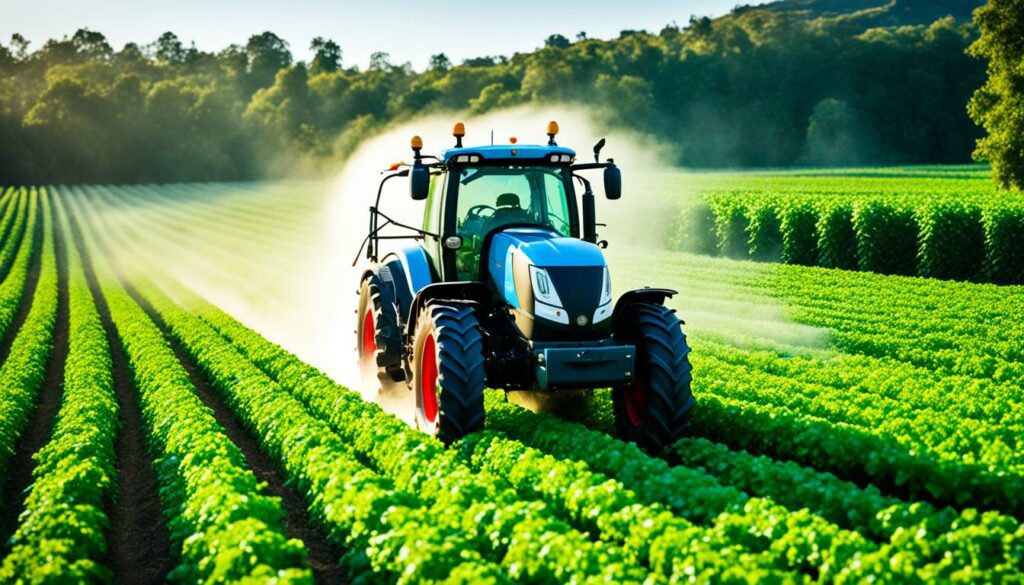
Japan has been a leader in using special coatings on fertilisers. These coatings, made of polyurethane and PE, help farms use nitrogen better. They stop some of this nitrogen from getting into the air. This means farmers can grow food without adding to the greenhouse effect. So, these coatings are good for farming and for our world.
Smart irrigation systems are also a big step forward. Since farming uses a lot of water, these systems aim to use water smarter. They use things like remote sensing to make sure crops get just the right amount of water. By reducing water waste, these systems protect our water resources. This tech shows how new ideas can improve age-old farming methods.
Investing in agricultural technology advancements helps make farming sustainable. New tech, like special fertiliser coatings and smart irrigation, brings big benefits. It’s these and upcoming technologies that will shape the future of farming. The hope is for these innovations to work together smoothly.
Using plastics wisely in farming helps meet our needs without harming the planet. It’s key to take care of the soil. This way, we keep the ground healthy and help wildlife thrive. Farming makes a big impact on the environment, so we must farm in ways that are safe for the Earth.

Boosting how fast soil breaks down plastics is a smart approach in farming. Special mulch films break down in soil, unlike regular plastic films. It’s important to switch to these if we want to lessen plastic harm. About half of farming plastics are these non-friendly types.
Using farming methods that are good for nature is crucial. For example, adding special coatings to fertilisers can stop too many nutrients from washing away. This helps farms use nitrogen better and protects the land around them. Also, keeping the use of plastic low and letting nature grow as it should helps maintain our environment.
Taking these steps makes sure a farm is good for the environment as a whole. We need to think about all parts of farming to protect our planet. This is how we can farm to meet our needs and look after our world for those who come after us.
Tackling the problem of plastic in farming requires practical solutions. It’s key to manage waste well. This involves farmers sorting plastics for easier recycling and cut costs. They can also compress plastic waste to save money on transport.
Using eco-friendly materials is a big move. Biodegradable plastics and advanced farm materials cost more upfront but help the environment a lot. They don’t harm the soil in the long run. They are essential in a full plan to cut plastic use in farming.
Many places use a lot of plastic mulch films, which help crops but add to plastic waste. Changing to greener options can lessen this use. It’s important to note that these films boost crop growth by keeping soil moist and aiding nutrient absorption.
Encouraging eco-friendly farming practices is crucial as well. Policies like the UK’s Plastic Pact set examples by promoting the end of single-use plastics. Such steps push for less plastic on farms. They show the way for others to follow.
There’s also room for better farming methods. Using pit silage and making hay more efficiently can reduce plastic. This helps the environment and saves money. It’s smart farming for a better future.
Here’s a quick look at how different approaches compare in reducing plastic:
| Strategy | Conventional Approach | Sustainable Solution |
|---|---|---|
| Silage Storage | Baled Silage | Pit Silage |
| Plastic Mulch | Conventional Plastic | Biodegradable Plastic |
| Plastic Waste Management | Mixed and Uncleaned | Segregated and Cleaned |
| Feed Bag Usage | Individual Packs | Bulk Buying and Sharing |
Implementing plastic reduction strategies in agriculture takes hard work. It involves managing waste better, using eco-friendly materials, and backing green policies. These actions can make a big difference in the health of the planet and farming’s success.
It’s vital to have long-term plans for sustainable farming. These address the problems linked to using a lot of plastics in farming today. The plans aim to promote long-term sustainability, improve farm techniques, and bring in new solutions to protect the environment.
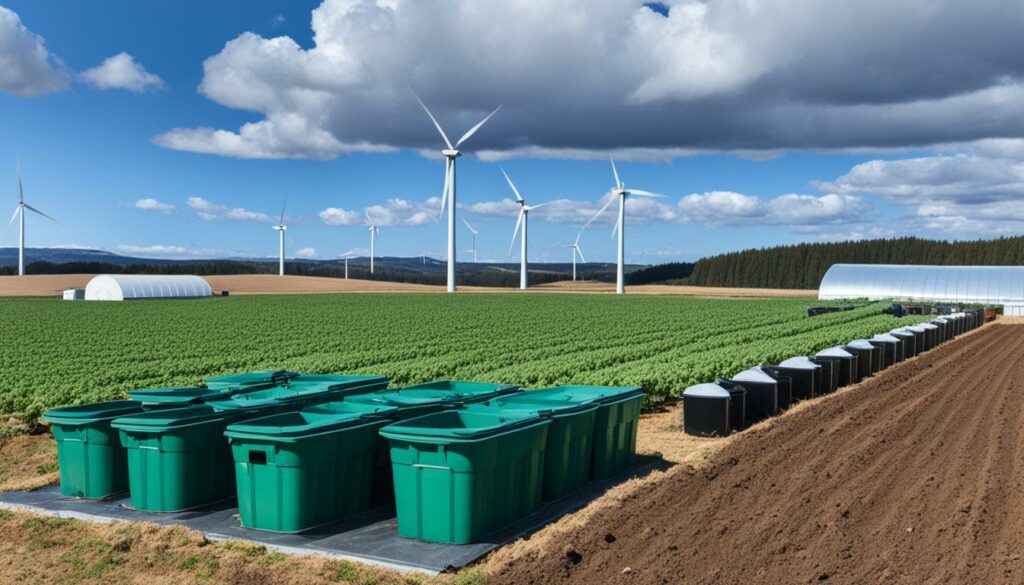
Creating new agricultural materials is key to using less plastic. New materials are made from plants and break down easily. They provide a good option instead of plastic films, which are half of all farm plastics. By pushing ahead with new materials, we can reduce soil pollution and lessen the harm farming does to nature.
Using resources wisely is also crucial. This includes water, fertilisers, and power. Doing this not only boosts crop growth but also lessens the mark farming leaves on the planet. Tools like precision farming and smart water systems help us use resources better, aiding sustainable farming.
Here’s why these strategies are important, using some facts:
| Metric | Impact |
|---|---|
| Plastic Use in Agriculture | Over 12 million tons annually |
| Mulch Films | 50% of agricultural plastics |
| Additional Cropland without Mulch Films in China | 3.9 million hectares |
| Global Greenhouse Gas Emissions from Agriculture | Almost one-third |
Using new agricultural materials and practices like resource-efficient farming helps. It supports global efforts like the UN’s work on plastics (UNEA 5.2). This way, we can keep farming sustainable without hurting food production or the environment.
Boosting sustainable farming needs a lot of focus on research and development (R&D). Collaborations between universities and farms are key. They help bring new ideas and ways to lessen the harm of plastic in farming.
Projects led by universities give a big push to find new ways and materials. They check if things like biodegradable mulch films and bio-based plastics really work in farming. This helps make sure what’s being done is based on the best science and actually works in the fields.
Getting R&D funding for sustainability is crucial for these projects to succeed. Money from the government, private businesses, and international groups is key. It allows for in-depth studies on how to make farming less harmful with things like biodegradable items and better ways to deal with plastic waste.
Collaborations in agriculture that get good funding can change farming for the better. By supporting these projects well, we build a strong system. This system can tackle problems now and in the future about how we farm sustainably.
Looking back, it’s clear that we need to tackle plastic use in farming from many angles. The Sustainable Agriculture Network warns us about plastic pollution’s dangers to our planet. It’s crucial to focus on sustainable methods and lower plastic use. Using plant-based packaging is a good step forward.
It’s vital to bring circular economy ideas like reuse and recycling into farming. These concepts cut down on plastic waste and encourage a greener farming style. Advanced farming methods like precision agriculture and agroforestry help us use less plastic and farm smarter.
Teaching people about the harm of plastic is key to making a change. We use over 10,000 chemicals in making plastics, and some are harmful. Switching to biodegradable plastics can be better for the earth. Everyone needs to work together to use plastic more wisely and find new materials. This teamwork, involving rules, learning, tech, and local efforts, is how we can have food and protect our planet.
In farming, plastic is mostly seen in mulch films, greenhouse covers, and irrigation tubes. They help grow more crops. Plastic also saves water, keeps pests away, and makes soil richer.
Plastic can get into the ground and harm the soil. This makes it hard for plants and animals to live together. Leftover plastic can destroy the soil and the life in it.
Farming plastic boosts harvests. It also lets farmers save water and handle pests. These are good for making more food without waste.
Using less plastic in farming is hard. It’s because plastic helps a lot in growing food. There aren’t many other good ways yet. So, stopping plastic can make less food.
We use machines and special ways to recycle farm plastics. Some plastics can turn into new things. We’re also making plastics that nature can break down.
Farmers now use plastic that nature can get rid of. They also choose to grow food in a natural way. Learning new things and working together helps make farming better for the earth.
Countries and groups have made rules to use less plastic in farming. These rules push for new ideas and better ways to farm without hurting the planet.
Teaching farmers helps them do less harm to the earth. It’s important that everyone knows how to farm without hurting the planet. Working together and sharing ideas makes it easier to choose the right way.
New ideas like special fertilisers and water systems are good for farms. They make growing food better for the earth. Investing money in smart technologies helps farmers take care of the planet.
Farming can be good for nature if we use the right plastic and ways. This means using plastic that goes away and keeping nature in mind. Doing this helps the land, plants, and animals live better together.
We should throw away plastic the right way and find other materials to use. Giving prizes for earth-friendly farming makes farmers try harder. This is good for growing food without making the earth sick.
Making less plastic and using nature more in farming is a good plan. This way we can farm for a long time without hurting the earth. Thinking ahead and taking care of our farm helps everyone live better.
Universities and farms can work together on new farming ideas. They need money and help from others to make these new things. Finding better ways to farm comes from working together and thinking of the earth.